

Stop saying ’sorry’ if you want to say thank you: A seriously insightful cartoon. 12 type secrets of the INFP personality. INFPs, who make up about 4-5 percent of the population, are unique individuals who care deeply about other people.
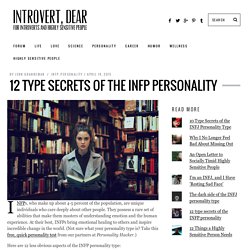
They possess a rare set of abilities that make them masters of understanding emotion and the human experience. At their best, INFPs bring emotional healing to others and inspire incredible change in the world. (Not sure what your personality type is? Take this free, quick personality test from our partners at Personality Hacker.) Here are 12 less obvious aspects of the INFP personality type: 1.
INFPs desire a certain level of emotional intensity, so they may unconsciously seek out relationships, books, poetry, music, travel, or charity work that evoke strong feelings. 10 Things You Need to Know Before Dating the Outgoing Introvert. How to connect deeply with anyone (in 5 minutes) 468k shares Share on Facebook Share on Twitter I’m going to share a game with you.

This game will reveal incredible things about whoever plays it; surprise, shock and delight complete strangers, and has kickstarted more friendships than I know how to count. Play along and you’ll see. I want you to imagine a desert, stretching out as far as your eyes can see. In this desert is a cube. Your first task is to describe the cube. The Highly Sensitive Person. By Elaine N.
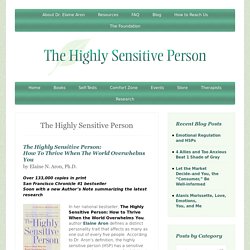
Aron, Ph.D. Over 133,000 copies in print San Francisco Chronicle #1 bestsellerSoon with a new Author’s Note summarizing the latest research In her national bestseller, The Highly Sensitive Person: How to Thrive When the World Overwhelms You, author Elaine Aron defines a distinct personality trait that affects as many as one out of every five people. According to Dr. Aron’s definition, the highly sensitive person (HSP) has a sensitive nervous system, is aware of subtleties in his/her surroundings, and is more easily overwhelmed when in a highly stimulating environment. Rage and Anger - The Common Sources of Personality Disorders. Rage and Anger: The Common Sources of Personality Disorders By: Dr.
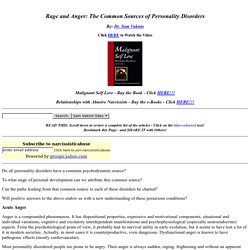
Sam Vaknin Click HERE to Watch the Video Malignant Self Love - Buy the Book - Click HERE!!! Relationships with Abusive Narcissists - Buy the e-Books - Click HERE!!! READ THIS: Scroll down to review a complete list of the articles - Click on the blue-coloured text! Do all personality disorders have a common psychodynamic source? To what stage of personal development can we attribute this common source?
Seligman2. Neil Gaiman on Why Scary Stories Appeal to Us, the Art of Fear in Children’s Books, and the Most Terrifying Ghosts Haunting Society. Why the Left-Brain Right-Brain Myth Will Probably Never Die. The left-brain right-brain myth will probably never die because it has become a powerful metaphor for different ways of thinking – logical, focused and analytic versus broad-minded and creative.
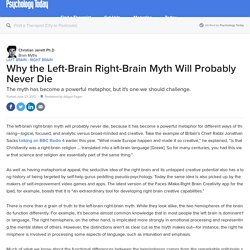
Take the example of Britain’s Chief Rabbi Jonathan Sacks talking on BBC Radio 4 earlier this year. “What made Europe happen and made it so creative,” he explained, “is that Christianity was a right-brain religion … translated into a left-brain language [Greek]. So for many centuries you had this view that science and religion are essentially part of the same thing.” As well as having metaphorical appeal, the seductive idea of the right brain and its untapped creative potential also has a long history of being targeted by self-help gurus peddling pseudo-psychology. Today the same idea is also picked up by the makers of self-improvement video games and apps. Left Brain vs. Right: It's a Myth, Research Finds. It's the foundation of myriad personality assessment tests, self-motivation books and team-building exercises – and it's all bunk.
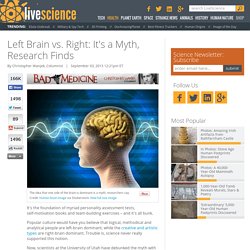
Popular culture would have you believe that logical, methodical and analytical people are left-brain dominant, while the creative and artistic types are right-brain dominant. Trouble is, science never really supported this notion. Now, scientists at the University of Utah have debunked the myth with an analysis of more than 1,000 brains. They found no evidence that people preferentially use their left or right brain. All of the study participants — and no doubt the scientists — were using their entire brain equally, throughout the course of the experiment. A paper describing this study appeared in August in the journal PLOS ONE. [10 Things You Didn't Know About the Brain] The preference to use one brain region more than others for certain functions, which scientists call lateralization, is indeed real, said lead author Dr. You Can't See It, But You'll Be A Different Person In 10 Years : Shots - Health News. INFP Personal Growth. INFPs are creative, sensitive souls who take their lives very seriously.
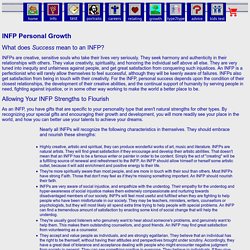
They seek harmony and authenticity in their relationships with others. They value creativity, spirituality, and honoring the individual self above all else. They are very tuned into inequity and unfairness against people, and get great satisfaction from conquering such injustices. An INFP is a perfectionist who will rarely allow themselves to feel successful, although they will be keenly aware of failures. INFPs also get satisfaction from being in touch with their creativity. As an INFP, you have gifts that are specific to your personality type that aren't natural strengths for other types.
Potential Problem Areas.